Comparative Analysis of Leadership and Management in Tesco Operations
VerifiedAdded on 2020/10/22
|16
|5115
|60
Report
AI Summary
This report provides a comprehensive analysis of leadership and management, using Tesco as a case study. It begins by differentiating between the roles and characteristics of leaders and managers, highlighting their similarities and differences. The report then delves into the functions of a manager, based on Fayol's principles, including planning, organizing, commanding, coordinating, and controlling. Furthermore, it explores various leadership styles, such as situational, systems, and contingency leadership, explaining their application within an organizational context. The second part of the report examines operations management approaches, including DMAIC, lean and agile manufacturing, Six Sigma, continuous improvement, and just-in-time inventory, with specific examples related to Tesco's operations. The report concludes with an overview of how external factors influence Tesco's operations and the impact of PESTLE factors on a store manager's decision-making process.
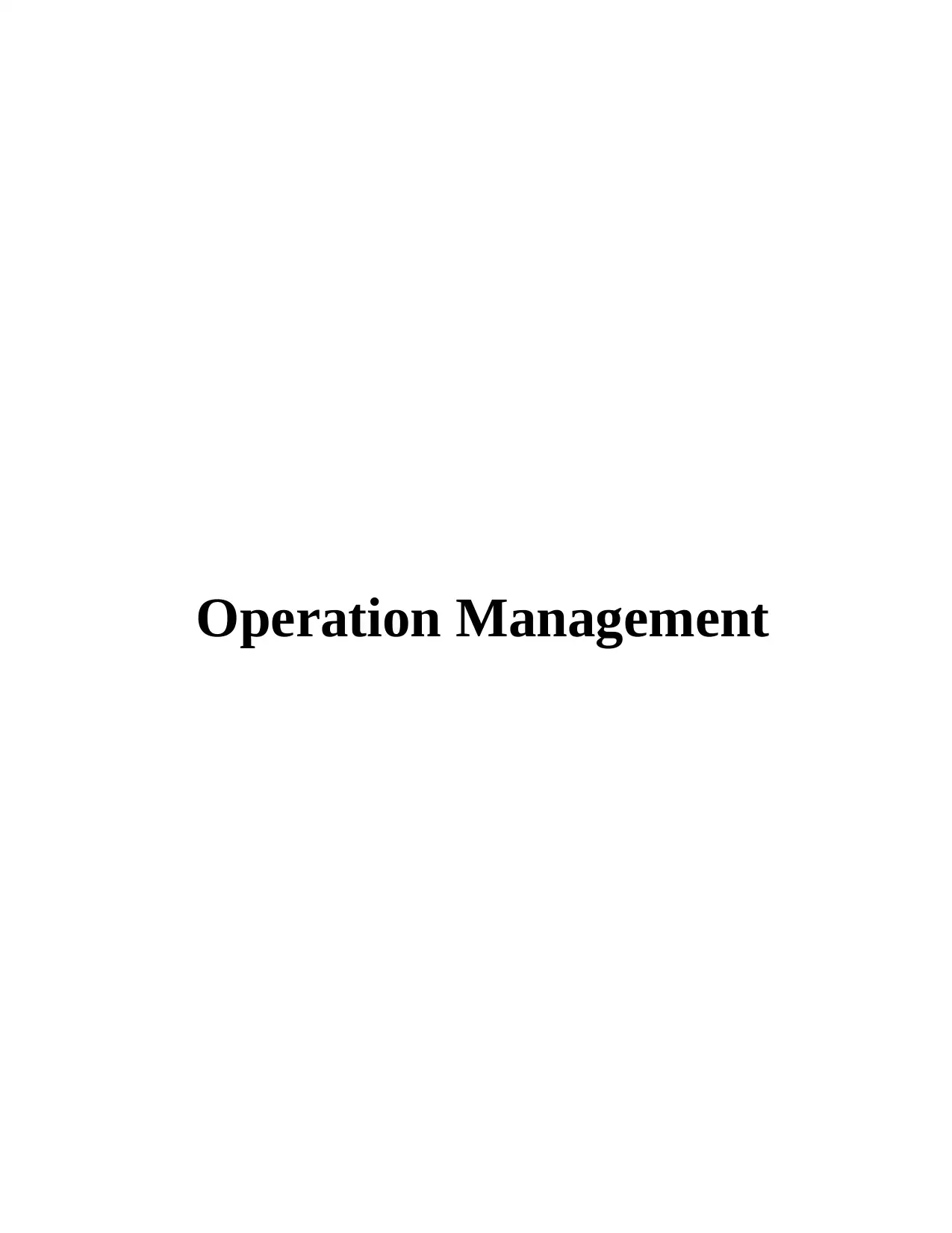
Operation Management
Paraphrase This Document
Need a fresh take? Get an instant paraphrase of this document with our AI Paraphraser
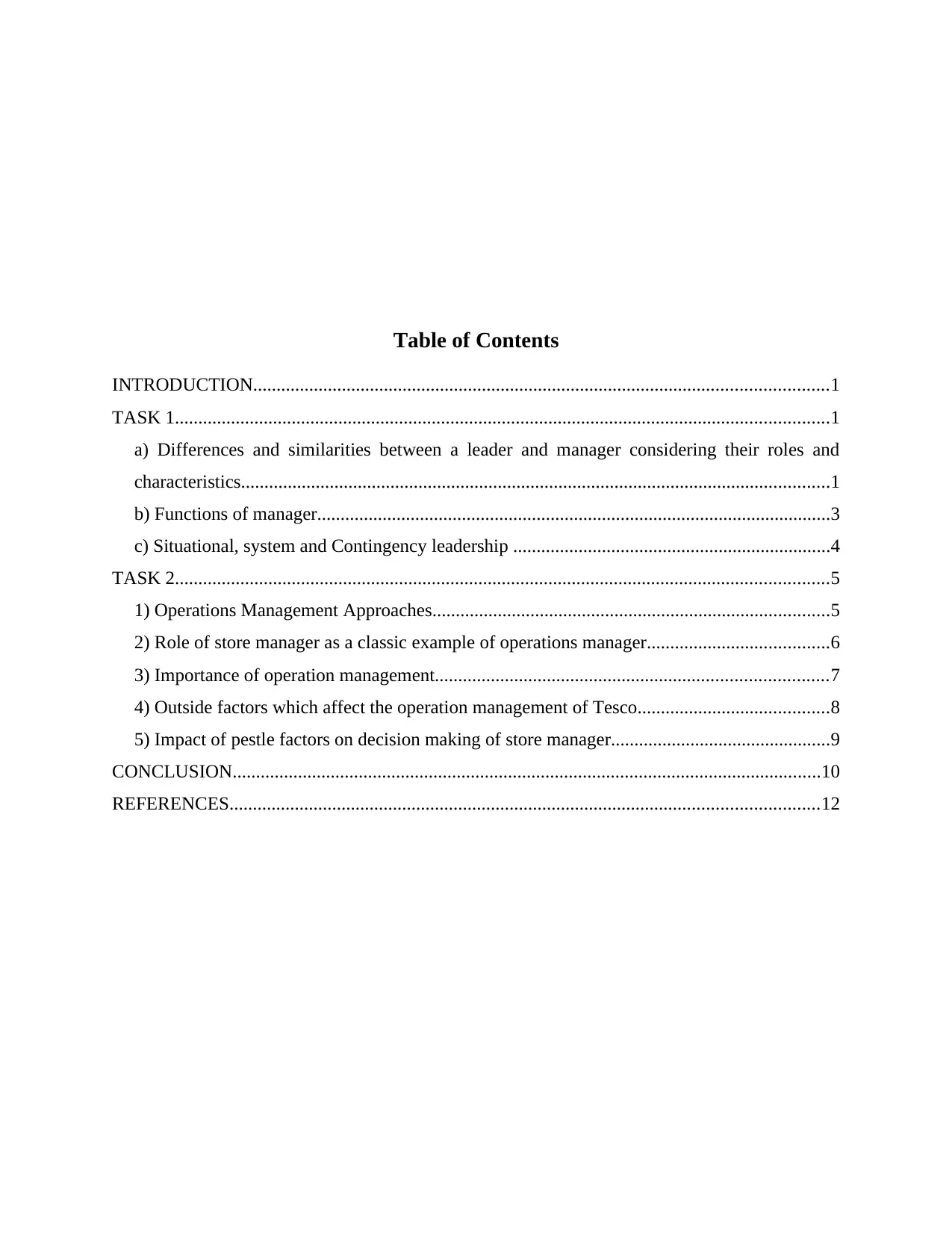
Table of Contents
INTRODUCTION...........................................................................................................................1
TASK 1............................................................................................................................................1
a) Differences and similarities between a leader and manager considering their roles and
characteristics..............................................................................................................................1
b) Functions of manager..............................................................................................................3
c) Situational, system and Contingency leadership ....................................................................4
TASK 2............................................................................................................................................5
1) Operations Management Approaches.....................................................................................5
2) Role of store manager as a classic example of operations manager.......................................6
3) Importance of operation management....................................................................................7
4) Outside factors which affect the operation management of Tesco.........................................8
5) Impact of pestle factors on decision making of store manager...............................................9
CONCLUSION..............................................................................................................................10
REFERENCES..............................................................................................................................12
INTRODUCTION...........................................................................................................................1
TASK 1............................................................................................................................................1
a) Differences and similarities between a leader and manager considering their roles and
characteristics..............................................................................................................................1
b) Functions of manager..............................................................................................................3
c) Situational, system and Contingency leadership ....................................................................4
TASK 2............................................................................................................................................5
1) Operations Management Approaches.....................................................................................5
2) Role of store manager as a classic example of operations manager.......................................6
3) Importance of operation management....................................................................................7
4) Outside factors which affect the operation management of Tesco.........................................8
5) Impact of pestle factors on decision making of store manager...............................................9
CONCLUSION..............................................................................................................................10
REFERENCES..............................................................................................................................12
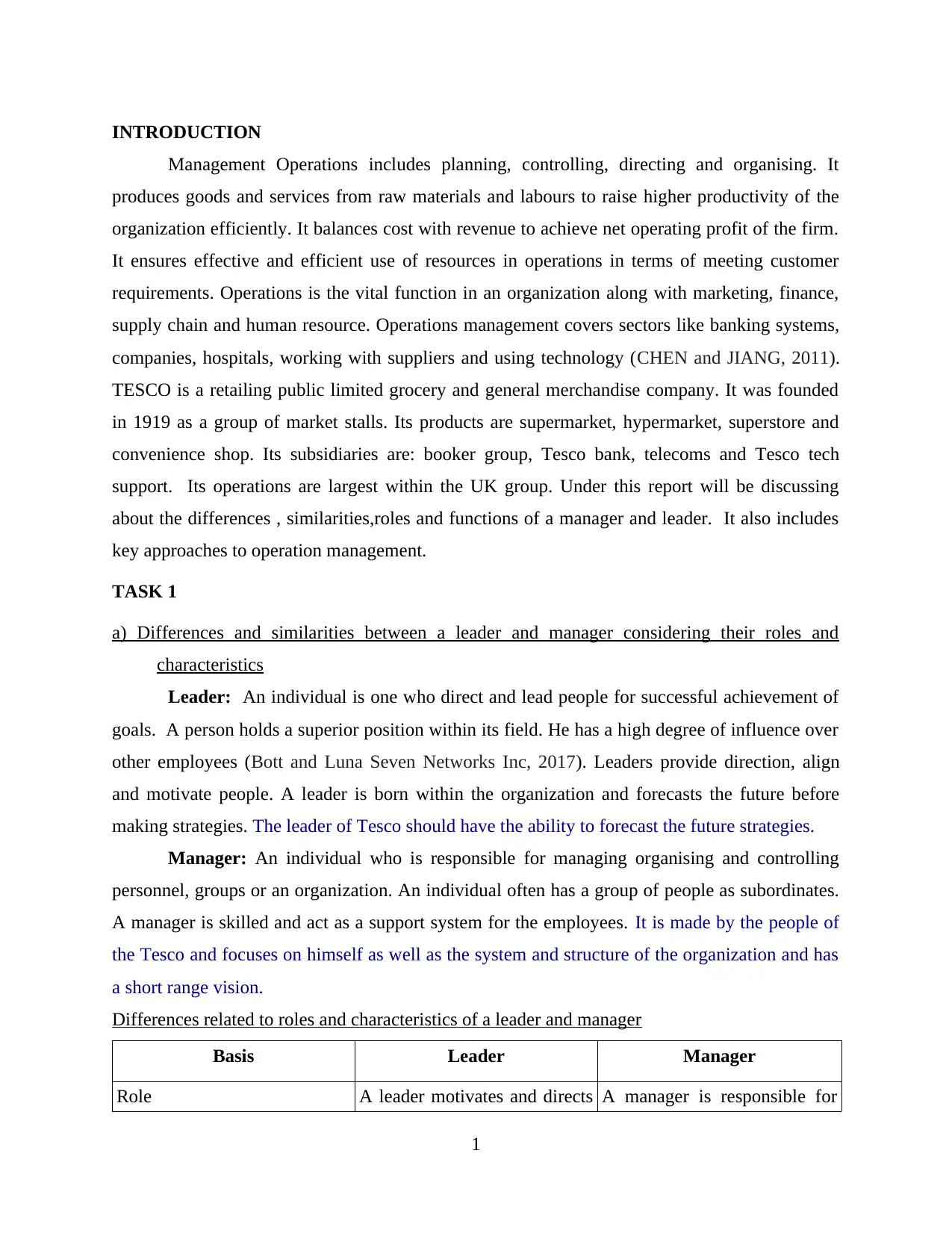
INTRODUCTION
Management Operations includes planning, controlling, directing and organising. It
produces goods and services from raw materials and labours to raise higher productivity of the
organization efficiently. It balances cost with revenue to achieve net operating profit of the firm.
It ensures effective and efficient use of resources in operations in terms of meeting customer
requirements. Operations is the vital function in an organization along with marketing, finance,
supply chain and human resource. Operations management covers sectors like banking systems,
companies, hospitals, working with suppliers and using technology (CHEN and JIANG, 2011).
TESCO is a retailing public limited grocery and general merchandise company. It was founded
in 1919 as a group of market stalls. Its products are supermarket, hypermarket, superstore and
convenience shop. Its subsidiaries are: booker group, Tesco bank, telecoms and Tesco tech
support. Its operations are largest within the UK group. Under this report will be discussing
about the differences , similarities,roles and functions of a manager and leader. It also includes
key approaches to operation management.
TASK 1
a) Differences and similarities between a leader and manager considering their roles and
characteristics
Leader: An individual is one who direct and lead people for successful achievement of
goals. A person holds a superior position within its field. He has a high degree of influence over
other employees (Bott and Luna Seven Networks Inc, 2017). Leaders provide direction, align
and motivate people. A leader is born within the organization and forecasts the future before
making strategies. The leader of Tesco should have the ability to forecast the future strategies.
Manager: An individual who is responsible for managing organising and controlling
personnel, groups or an organization. An individual often has a group of people as subordinates.
A manager is skilled and act as a support system for the employees. It is made by the people of
the Tesco and focuses on himself as well as the system and structure of the organization and has
a short range vision.
Differences related to roles and characteristics of a leader and manager
Basis Leader Manager
Role A leader motivates and directs A manager is responsible for
1
Management Operations includes planning, controlling, directing and organising. It
produces goods and services from raw materials and labours to raise higher productivity of the
organization efficiently. It balances cost with revenue to achieve net operating profit of the firm.
It ensures effective and efficient use of resources in operations in terms of meeting customer
requirements. Operations is the vital function in an organization along with marketing, finance,
supply chain and human resource. Operations management covers sectors like banking systems,
companies, hospitals, working with suppliers and using technology (CHEN and JIANG, 2011).
TESCO is a retailing public limited grocery and general merchandise company. It was founded
in 1919 as a group of market stalls. Its products are supermarket, hypermarket, superstore and
convenience shop. Its subsidiaries are: booker group, Tesco bank, telecoms and Tesco tech
support. Its operations are largest within the UK group. Under this report will be discussing
about the differences , similarities,roles and functions of a manager and leader. It also includes
key approaches to operation management.
TASK 1
a) Differences and similarities between a leader and manager considering their roles and
characteristics
Leader: An individual is one who direct and lead people for successful achievement of
goals. A person holds a superior position within its field. He has a high degree of influence over
other employees (Bott and Luna Seven Networks Inc, 2017). Leaders provide direction, align
and motivate people. A leader is born within the organization and forecasts the future before
making strategies. The leader of Tesco should have the ability to forecast the future strategies.
Manager: An individual who is responsible for managing organising and controlling
personnel, groups or an organization. An individual often has a group of people as subordinates.
A manager is skilled and act as a support system for the employees. It is made by the people of
the Tesco and focuses on himself as well as the system and structure of the organization and has
a short range vision.
Differences related to roles and characteristics of a leader and manager
Basis Leader Manager
Role A leader motivates and directs A manager is responsible for
1
⊘ This is a preview!⊘
Do you want full access?
Subscribe today to unlock all pages.

Trusted by 1+ million students worldwide
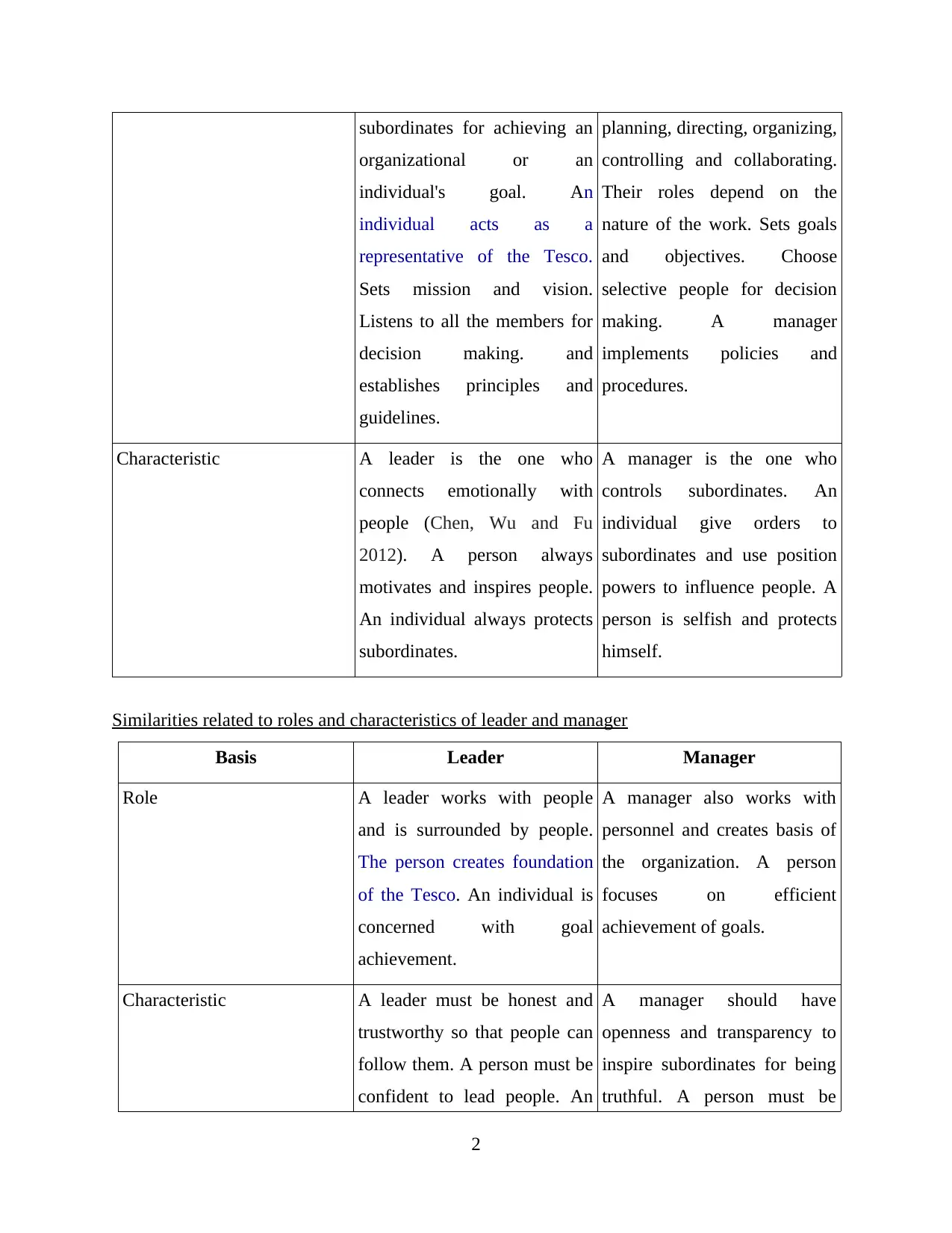
subordinates for achieving an
organizational or an
individual's goal. An
individual acts as a
representative of the Tesco.
Sets mission and vision.
Listens to all the members for
decision making. and
establishes principles and
guidelines.
planning, directing, organizing,
controlling and collaborating.
Their roles depend on the
nature of the work. Sets goals
and objectives. Choose
selective people for decision
making. A manager
implements policies and
procedures.
Characteristic A leader is the one who
connects emotionally with
people (Chen, Wu and Fu
2012). A person always
motivates and inspires people.
An individual always protects
subordinates.
A manager is the one who
controls subordinates. An
individual give orders to
subordinates and use position
powers to influence people. A
person is selfish and protects
himself.
Similarities related to roles and characteristics of leader and manager
Basis Leader Manager
Role A leader works with people
and is surrounded by people.
The person creates foundation
of the Tesco. An individual is
concerned with goal
achievement.
A manager also works with
personnel and creates basis of
the organization. A person
focuses on efficient
achievement of goals.
Characteristic A leader must be honest and
trustworthy so that people can
follow them. A person must be
confident to lead people. An
A manager should have
openness and transparency to
inspire subordinates for being
truthful. A person must be
2
organizational or an
individual's goal. An
individual acts as a
representative of the Tesco.
Sets mission and vision.
Listens to all the members for
decision making. and
establishes principles and
guidelines.
planning, directing, organizing,
controlling and collaborating.
Their roles depend on the
nature of the work. Sets goals
and objectives. Choose
selective people for decision
making. A manager
implements policies and
procedures.
Characteristic A leader is the one who
connects emotionally with
people (Chen, Wu and Fu
2012). A person always
motivates and inspires people.
An individual always protects
subordinates.
A manager is the one who
controls subordinates. An
individual give orders to
subordinates and use position
powers to influence people. A
person is selfish and protects
himself.
Similarities related to roles and characteristics of leader and manager
Basis Leader Manager
Role A leader works with people
and is surrounded by people.
The person creates foundation
of the Tesco. An individual is
concerned with goal
achievement.
A manager also works with
personnel and creates basis of
the organization. A person
focuses on efficient
achievement of goals.
Characteristic A leader must be honest and
trustworthy so that people can
follow them. A person must be
confident to lead people. An
A manager should have
openness and transparency to
inspire subordinates for being
truthful. A person must be
2
Paraphrase This Document
Need a fresh take? Get an instant paraphrase of this document with our AI Paraphraser
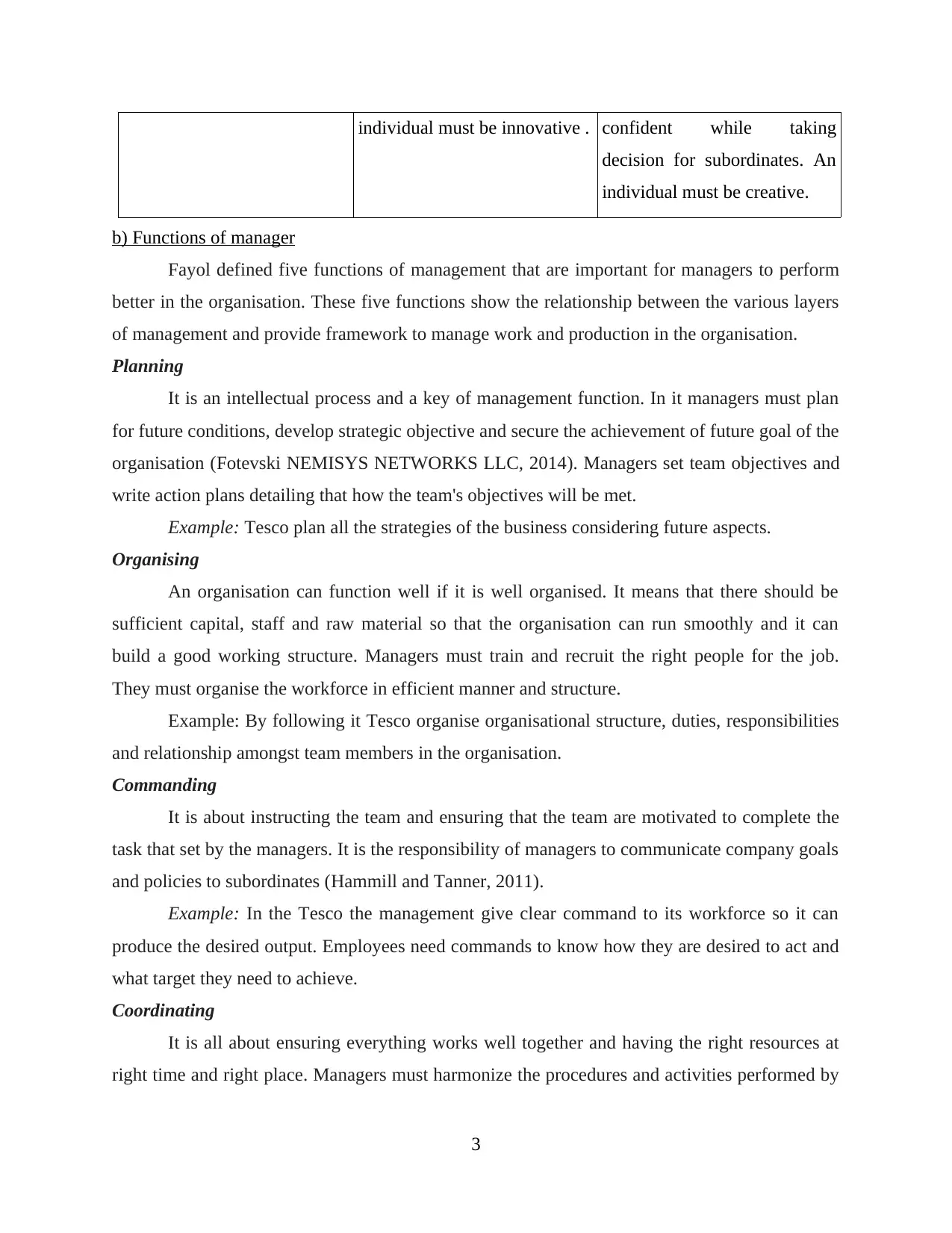
individual must be innovative . confident while taking
decision for subordinates. An
individual must be creative.
b) Functions of manager
Fayol defined five functions of management that are important for managers to perform
better in the organisation. These five functions show the relationship between the various layers
of management and provide framework to manage work and production in the organisation.
Planning
It is an intellectual process and a key of management function. In it managers must plan
for future conditions, develop strategic objective and secure the achievement of future goal of the
organisation (Fotevski NEMISYS NETWORKS LLC, 2014). Managers set team objectives and
write action plans detailing that how the team's objectives will be met.
Example: Tesco plan all the strategies of the business considering future aspects.
Organising
An organisation can function well if it is well organised. It means that there should be
sufficient capital, staff and raw material so that the organisation can run smoothly and it can
build a good working structure. Managers must train and recruit the right people for the job.
They must organise the workforce in efficient manner and structure.
Example: By following it Tesco organise organisational structure, duties, responsibilities
and relationship amongst team members in the organisation.
Commanding
It is about instructing the team and ensuring that the team are motivated to complete the
task that set by the managers. It is the responsibility of managers to communicate company goals
and policies to subordinates (Hammill and Tanner, 2011).
Example: In the Tesco the management give clear command to its workforce so it can
produce the desired output. Employees need commands to know how they are desired to act and
what target they need to achieve.
Coordinating
It is all about ensuring everything works well together and having the right resources at
right time and right place. Managers must harmonize the procedures and activities performed by
3
decision for subordinates. An
individual must be creative.
b) Functions of manager
Fayol defined five functions of management that are important for managers to perform
better in the organisation. These five functions show the relationship between the various layers
of management and provide framework to manage work and production in the organisation.
Planning
It is an intellectual process and a key of management function. In it managers must plan
for future conditions, develop strategic objective and secure the achievement of future goal of the
organisation (Fotevski NEMISYS NETWORKS LLC, 2014). Managers set team objectives and
write action plans detailing that how the team's objectives will be met.
Example: Tesco plan all the strategies of the business considering future aspects.
Organising
An organisation can function well if it is well organised. It means that there should be
sufficient capital, staff and raw material so that the organisation can run smoothly and it can
build a good working structure. Managers must train and recruit the right people for the job.
They must organise the workforce in efficient manner and structure.
Example: By following it Tesco organise organisational structure, duties, responsibilities
and relationship amongst team members in the organisation.
Commanding
It is about instructing the team and ensuring that the team are motivated to complete the
task that set by the managers. It is the responsibility of managers to communicate company goals
and policies to subordinates (Hammill and Tanner, 2011).
Example: In the Tesco the management give clear command to its workforce so it can
produce the desired output. Employees need commands to know how they are desired to act and
what target they need to achieve.
Coordinating
It is all about ensuring everything works well together and having the right resources at
right time and right place. Managers must harmonize the procedures and activities performed by
3
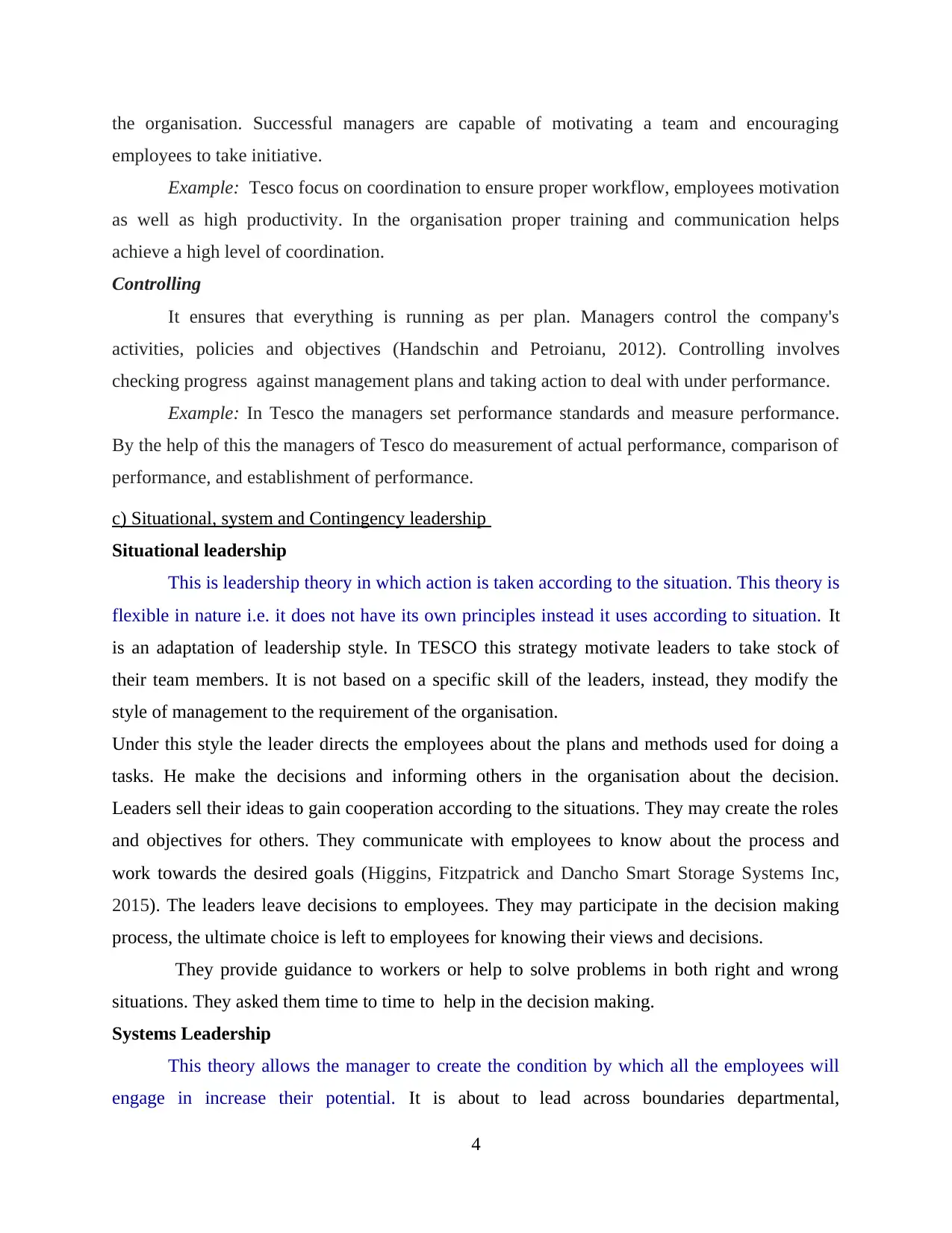
the organisation. Successful managers are capable of motivating a team and encouraging
employees to take initiative.
Example: Tesco focus on coordination to ensure proper workflow, employees motivation
as well as high productivity. In the organisation proper training and communication helps
achieve a high level of coordination.
Controlling
It ensures that everything is running as per plan. Managers control the company's
activities, policies and objectives (Handschin and Petroianu, 2012). Controlling involves
checking progress against management plans and taking action to deal with under performance.
Example: In Tesco the managers set performance standards and measure performance.
By the help of this the managers of Tesco do measurement of actual performance, comparison of
performance, and establishment of performance.
c) Situational, system and Contingency leadership
Situational leadership
This is leadership theory in which action is taken according to the situation. This theory is
flexible in nature i.e. it does not have its own principles instead it uses according to situation. It
is an adaptation of leadership style. In TESCO this strategy motivate leaders to take stock of
their team members. It is not based on a specific skill of the leaders, instead, they modify the
style of management to the requirement of the organisation.
Under this style the leader directs the employees about the plans and methods used for doing a
tasks. He make the decisions and informing others in the organisation about the decision.
Leaders sell their ideas to gain cooperation according to the situations. They may create the roles
and objectives for others. They communicate with employees to know about the process and
work towards the desired goals (Higgins, Fitzpatrick and Dancho Smart Storage Systems Inc,
2015). The leaders leave decisions to employees. They may participate in the decision making
process, the ultimate choice is left to employees for knowing their views and decisions.
They provide guidance to workers or help to solve problems in both right and wrong
situations. They asked them time to time to help in the decision making.
Systems Leadership
This theory allows the manager to create the condition by which all the employees will
engage in increase their potential. It is about to lead across boundaries departmental,
4
employees to take initiative.
Example: Tesco focus on coordination to ensure proper workflow, employees motivation
as well as high productivity. In the organisation proper training and communication helps
achieve a high level of coordination.
Controlling
It ensures that everything is running as per plan. Managers control the company's
activities, policies and objectives (Handschin and Petroianu, 2012). Controlling involves
checking progress against management plans and taking action to deal with under performance.
Example: In Tesco the managers set performance standards and measure performance.
By the help of this the managers of Tesco do measurement of actual performance, comparison of
performance, and establishment of performance.
c) Situational, system and Contingency leadership
Situational leadership
This is leadership theory in which action is taken according to the situation. This theory is
flexible in nature i.e. it does not have its own principles instead it uses according to situation. It
is an adaptation of leadership style. In TESCO this strategy motivate leaders to take stock of
their team members. It is not based on a specific skill of the leaders, instead, they modify the
style of management to the requirement of the organisation.
Under this style the leader directs the employees about the plans and methods used for doing a
tasks. He make the decisions and informing others in the organisation about the decision.
Leaders sell their ideas to gain cooperation according to the situations. They may create the roles
and objectives for others. They communicate with employees to know about the process and
work towards the desired goals (Higgins, Fitzpatrick and Dancho Smart Storage Systems Inc,
2015). The leaders leave decisions to employees. They may participate in the decision making
process, the ultimate choice is left to employees for knowing their views and decisions.
They provide guidance to workers or help to solve problems in both right and wrong
situations. They asked them time to time to help in the decision making.
Systems Leadership
This theory allows the manager to create the condition by which all the employees will
engage in increase their potential. It is about to lead across boundaries departmental,
4
⊘ This is a preview!⊘
Do you want full access?
Subscribe today to unlock all pages.

Trusted by 1+ million students worldwide
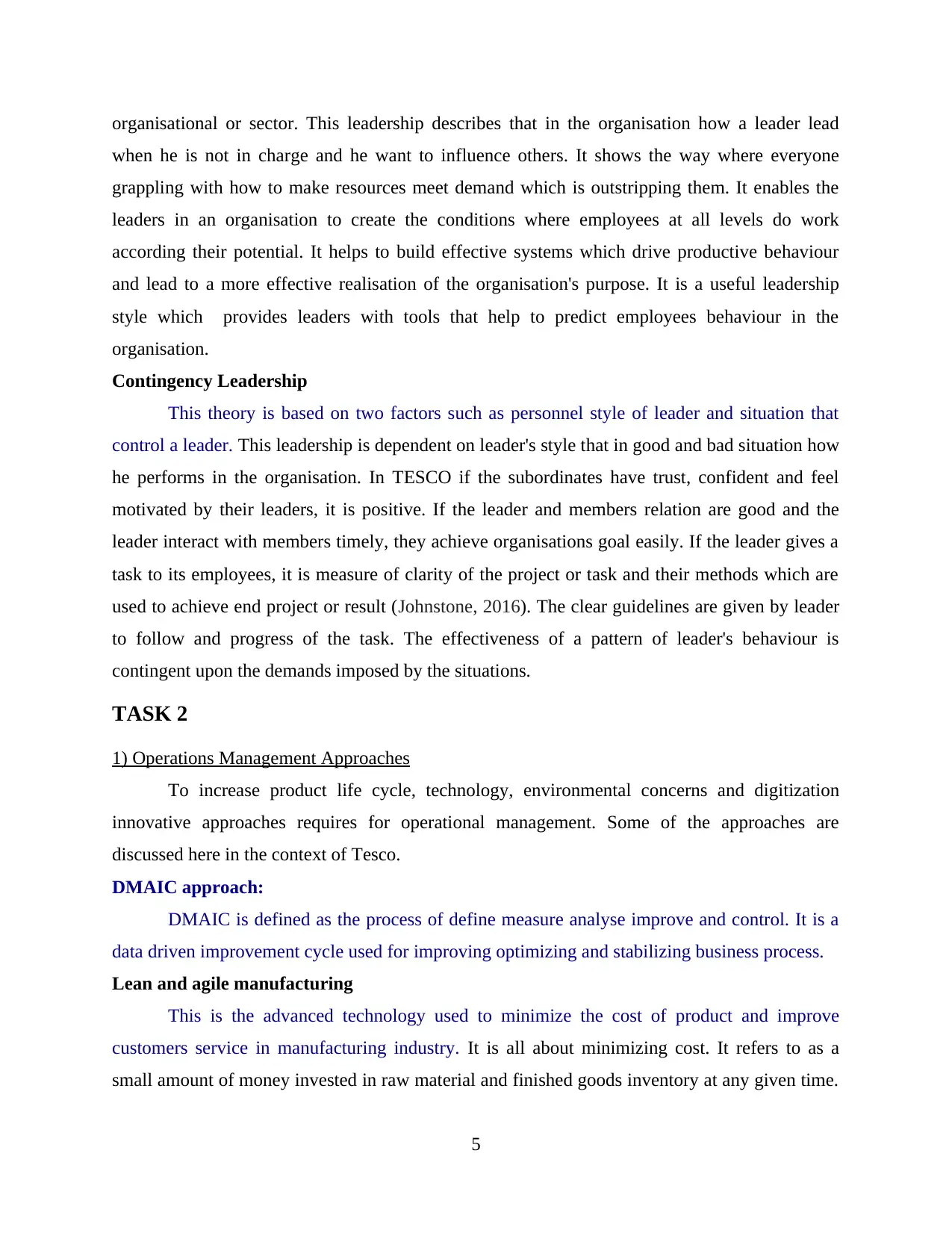
organisational or sector. This leadership describes that in the organisation how a leader lead
when he is not in charge and he want to influence others. It shows the way where everyone
grappling with how to make resources meet demand which is outstripping them. It enables the
leaders in an organisation to create the conditions where employees at all levels do work
according their potential. It helps to build effective systems which drive productive behaviour
and lead to a more effective realisation of the organisation's purpose. It is a useful leadership
style which provides leaders with tools that help to predict employees behaviour in the
organisation.
Contingency Leadership
This theory is based on two factors such as personnel style of leader and situation that
control a leader. This leadership is dependent on leader's style that in good and bad situation how
he performs in the organisation. In TESCO if the subordinates have trust, confident and feel
motivated by their leaders, it is positive. If the leader and members relation are good and the
leader interact with members timely, they achieve organisations goal easily. If the leader gives a
task to its employees, it is measure of clarity of the project or task and their methods which are
used to achieve end project or result (Johnstone, 2016). The clear guidelines are given by leader
to follow and progress of the task. The effectiveness of a pattern of leader's behaviour is
contingent upon the demands imposed by the situations.
TASK 2
1) Operations Management Approaches
To increase product life cycle, technology, environmental concerns and digitization
innovative approaches requires for operational management. Some of the approaches are
discussed here in the context of Tesco.
DMAIC approach:
DMAIC is defined as the process of define measure analyse improve and control. It is a
data driven improvement cycle used for improving optimizing and stabilizing business process.
Lean and agile manufacturing
This is the advanced technology used to minimize the cost of product and improve
customers service in manufacturing industry. It is all about minimizing cost. It refers to as a
small amount of money invested in raw material and finished goods inventory at any given time.
5
when he is not in charge and he want to influence others. It shows the way where everyone
grappling with how to make resources meet demand which is outstripping them. It enables the
leaders in an organisation to create the conditions where employees at all levels do work
according their potential. It helps to build effective systems which drive productive behaviour
and lead to a more effective realisation of the organisation's purpose. It is a useful leadership
style which provides leaders with tools that help to predict employees behaviour in the
organisation.
Contingency Leadership
This theory is based on two factors such as personnel style of leader and situation that
control a leader. This leadership is dependent on leader's style that in good and bad situation how
he performs in the organisation. In TESCO if the subordinates have trust, confident and feel
motivated by their leaders, it is positive. If the leader and members relation are good and the
leader interact with members timely, they achieve organisations goal easily. If the leader gives a
task to its employees, it is measure of clarity of the project or task and their methods which are
used to achieve end project or result (Johnstone, 2016). The clear guidelines are given by leader
to follow and progress of the task. The effectiveness of a pattern of leader's behaviour is
contingent upon the demands imposed by the situations.
TASK 2
1) Operations Management Approaches
To increase product life cycle, technology, environmental concerns and digitization
innovative approaches requires for operational management. Some of the approaches are
discussed here in the context of Tesco.
DMAIC approach:
DMAIC is defined as the process of define measure analyse improve and control. It is a
data driven improvement cycle used for improving optimizing and stabilizing business process.
Lean and agile manufacturing
This is the advanced technology used to minimize the cost of product and improve
customers service in manufacturing industry. It is all about minimizing cost. It refers to as a
small amount of money invested in raw material and finished goods inventory at any given time.
5
Paraphrase This Document
Need a fresh take? Get an instant paraphrase of this document with our AI Paraphraser
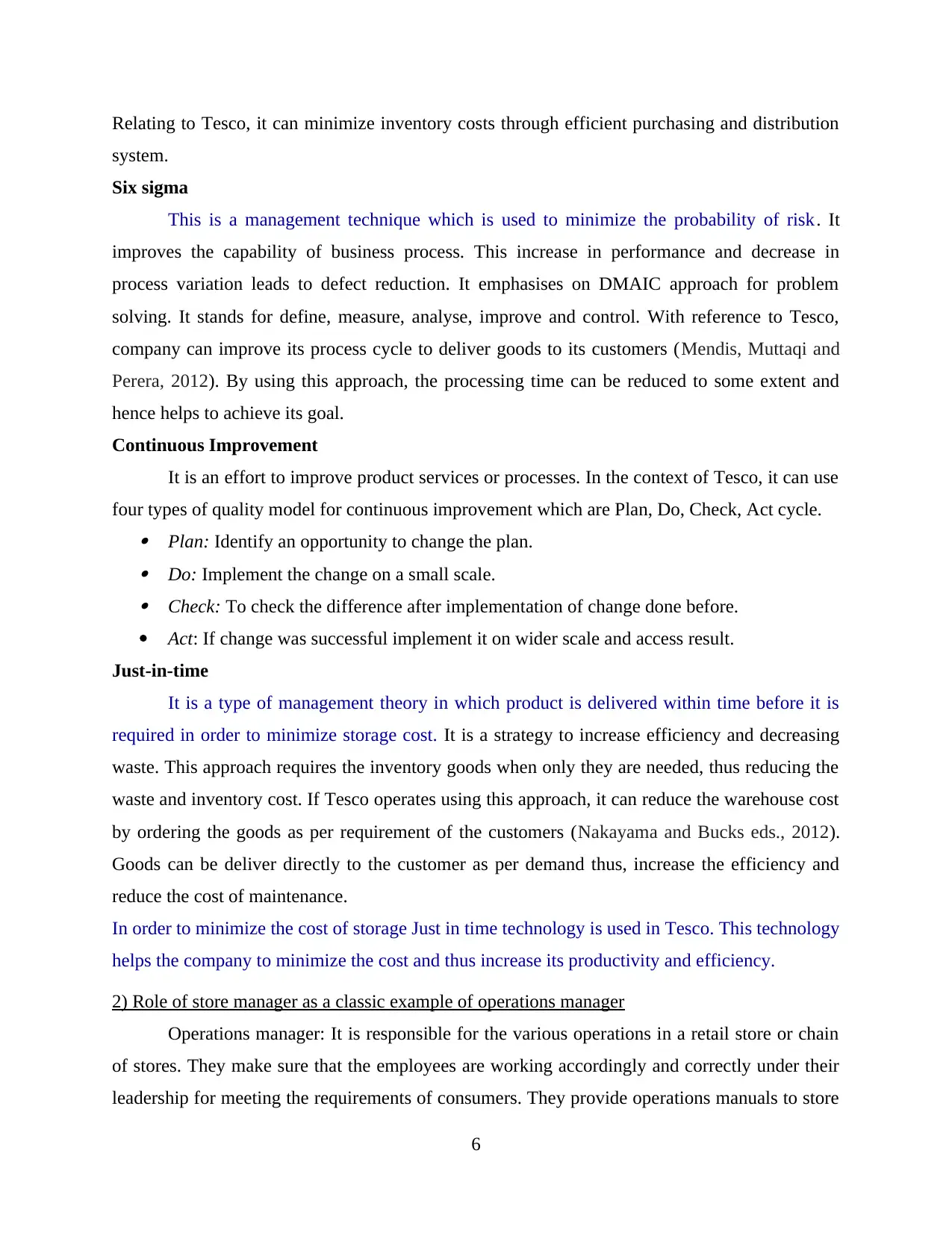
Relating to Tesco, it can minimize inventory costs through efficient purchasing and distribution
system.
Six sigma
This is a management technique which is used to minimize the probability of risk. It
improves the capability of business process. This increase in performance and decrease in
process variation leads to defect reduction. It emphasises on DMAIC approach for problem
solving. It stands for define, measure, analyse, improve and control. With reference to Tesco,
company can improve its process cycle to deliver goods to its customers (Mendis, Muttaqi and
Perera, 2012). By using this approach, the processing time can be reduced to some extent and
hence helps to achieve its goal.
Continuous Improvement
It is an effort to improve product services or processes. In the context of Tesco, it can use
four types of quality model for continuous improvement which are Plan, Do, Check, Act cycle. Plan: Identify an opportunity to change the plan. Do: Implement the change on a small scale. Check: To check the difference after implementation of change done before.
Act: If change was successful implement it on wider scale and access result.
Just-in-time
It is a type of management theory in which product is delivered within time before it is
required in order to minimize storage cost. It is a strategy to increase efficiency and decreasing
waste. This approach requires the inventory goods when only they are needed, thus reducing the
waste and inventory cost. If Tesco operates using this approach, it can reduce the warehouse cost
by ordering the goods as per requirement of the customers (Nakayama and Bucks eds., 2012).
Goods can be deliver directly to the customer as per demand thus, increase the efficiency and
reduce the cost of maintenance.
In order to minimize the cost of storage Just in time technology is used in Tesco. This technology
helps the company to minimize the cost and thus increase its productivity and efficiency.
2) Role of store manager as a classic example of operations manager
Operations manager: It is responsible for the various operations in a retail store or chain
of stores. They make sure that the employees are working accordingly and correctly under their
leadership for meeting the requirements of consumers. They provide operations manuals to store
6
system.
Six sigma
This is a management technique which is used to minimize the probability of risk. It
improves the capability of business process. This increase in performance and decrease in
process variation leads to defect reduction. It emphasises on DMAIC approach for problem
solving. It stands for define, measure, analyse, improve and control. With reference to Tesco,
company can improve its process cycle to deliver goods to its customers (Mendis, Muttaqi and
Perera, 2012). By using this approach, the processing time can be reduced to some extent and
hence helps to achieve its goal.
Continuous Improvement
It is an effort to improve product services or processes. In the context of Tesco, it can use
four types of quality model for continuous improvement which are Plan, Do, Check, Act cycle. Plan: Identify an opportunity to change the plan. Do: Implement the change on a small scale. Check: To check the difference after implementation of change done before.
Act: If change was successful implement it on wider scale and access result.
Just-in-time
It is a type of management theory in which product is delivered within time before it is
required in order to minimize storage cost. It is a strategy to increase efficiency and decreasing
waste. This approach requires the inventory goods when only they are needed, thus reducing the
waste and inventory cost. If Tesco operates using this approach, it can reduce the warehouse cost
by ordering the goods as per requirement of the customers (Nakayama and Bucks eds., 2012).
Goods can be deliver directly to the customer as per demand thus, increase the efficiency and
reduce the cost of maintenance.
In order to minimize the cost of storage Just in time technology is used in Tesco. This technology
helps the company to minimize the cost and thus increase its productivity and efficiency.
2) Role of store manager as a classic example of operations manager
Operations manager: It is responsible for the various operations in a retail store or chain
of stores. They make sure that the employees are working accordingly and correctly under their
leadership for meeting the requirements of consumers. They provide operations manuals to store
6
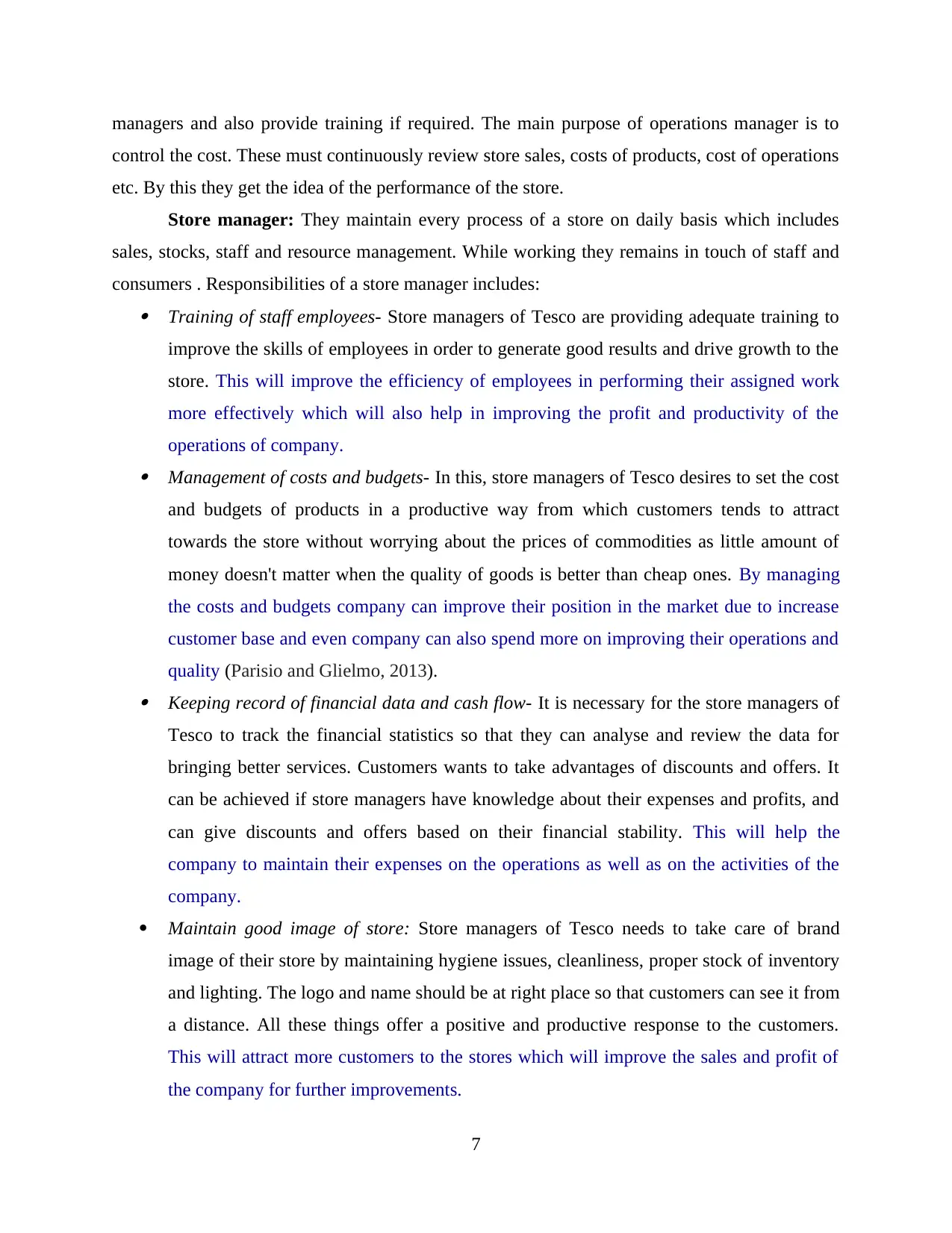
managers and also provide training if required. The main purpose of operations manager is to
control the cost. These must continuously review store sales, costs of products, cost of operations
etc. By this they get the idea of the performance of the store.
Store manager: They maintain every process of a store on daily basis which includes
sales, stocks, staff and resource management. While working they remains in touch of staff and
consumers . Responsibilities of a store manager includes: Training of staff employees- Store managers of Tesco are providing adequate training to
improve the skills of employees in order to generate good results and drive growth to the
store. This will improve the efficiency of employees in performing their assigned work
more effectively which will also help in improving the profit and productivity of the
operations of company. Management of costs and budgets- In this, store managers of Tesco desires to set the cost
and budgets of products in a productive way from which customers tends to attract
towards the store without worrying about the prices of commodities as little amount of
money doesn't matter when the quality of goods is better than cheap ones. By managing
the costs and budgets company can improve their position in the market due to increase
customer base and even company can also spend more on improving their operations and
quality (Parisio and Glielmo, 2013). Keeping record of financial data and cash flow- It is necessary for the store managers of
Tesco to track the financial statistics so that they can analyse and review the data for
bringing better services. Customers wants to take advantages of discounts and offers. It
can be achieved if store managers have knowledge about their expenses and profits, and
can give discounts and offers based on their financial stability. This will help the
company to maintain their expenses on the operations as well as on the activities of the
company.
Maintain good image of store: Store managers of Tesco needs to take care of brand
image of their store by maintaining hygiene issues, cleanliness, proper stock of inventory
and lighting. The logo and name should be at right place so that customers can see it from
a distance. All these things offer a positive and productive response to the customers.
This will attract more customers to the stores which will improve the sales and profit of
the company for further improvements.
7
control the cost. These must continuously review store sales, costs of products, cost of operations
etc. By this they get the idea of the performance of the store.
Store manager: They maintain every process of a store on daily basis which includes
sales, stocks, staff and resource management. While working they remains in touch of staff and
consumers . Responsibilities of a store manager includes: Training of staff employees- Store managers of Tesco are providing adequate training to
improve the skills of employees in order to generate good results and drive growth to the
store. This will improve the efficiency of employees in performing their assigned work
more effectively which will also help in improving the profit and productivity of the
operations of company. Management of costs and budgets- In this, store managers of Tesco desires to set the cost
and budgets of products in a productive way from which customers tends to attract
towards the store without worrying about the prices of commodities as little amount of
money doesn't matter when the quality of goods is better than cheap ones. By managing
the costs and budgets company can improve their position in the market due to increase
customer base and even company can also spend more on improving their operations and
quality (Parisio and Glielmo, 2013). Keeping record of financial data and cash flow- It is necessary for the store managers of
Tesco to track the financial statistics so that they can analyse and review the data for
bringing better services. Customers wants to take advantages of discounts and offers. It
can be achieved if store managers have knowledge about their expenses and profits, and
can give discounts and offers based on their financial stability. This will help the
company to maintain their expenses on the operations as well as on the activities of the
company.
Maintain good image of store: Store managers of Tesco needs to take care of brand
image of their store by maintaining hygiene issues, cleanliness, proper stock of inventory
and lighting. The logo and name should be at right place so that customers can see it from
a distance. All these things offer a positive and productive response to the customers.
This will attract more customers to the stores which will improve the sales and profit of
the company for further improvements.
7
⊘ This is a preview!⊘
Do you want full access?
Subscribe today to unlock all pages.

Trusted by 1+ million students worldwide
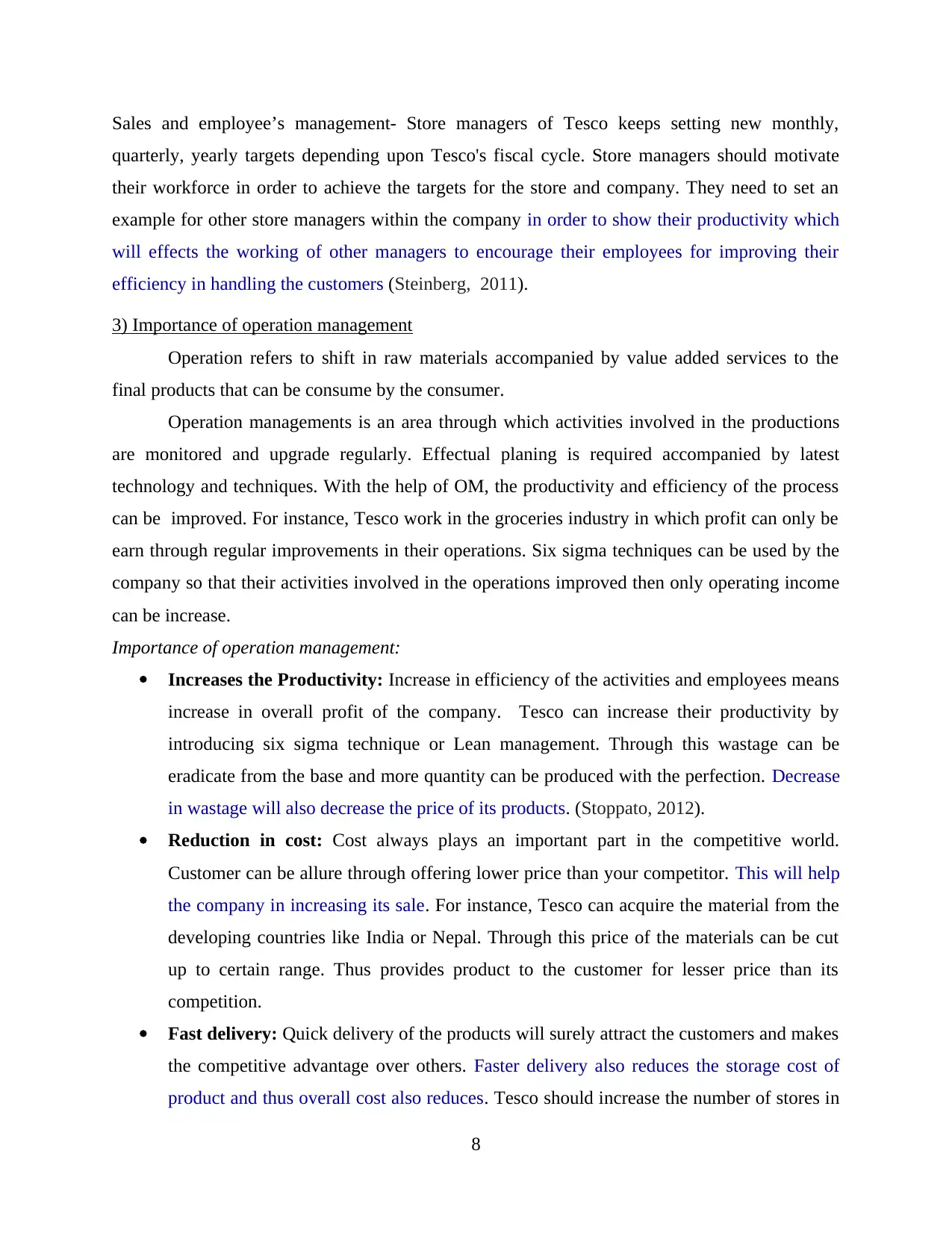
Sales and employee’s management- Store managers of Tesco keeps setting new monthly,
quarterly, yearly targets depending upon Tesco's fiscal cycle. Store managers should motivate
their workforce in order to achieve the targets for the store and company. They need to set an
example for other store managers within the company in order to show their productivity which
will effects the working of other managers to encourage their employees for improving their
efficiency in handling the customers (Steinberg, 2011).
3) Importance of operation management
Operation refers to shift in raw materials accompanied by value added services to the
final products that can be consume by the consumer.
Operation managements is an area through which activities involved in the productions
are monitored and upgrade regularly. Effectual planing is required accompanied by latest
technology and techniques. With the help of OM, the productivity and efficiency of the process
can be improved. For instance, Tesco work in the groceries industry in which profit can only be
earn through regular improvements in their operations. Six sigma techniques can be used by the
company so that their activities involved in the operations improved then only operating income
can be increase.
Importance of operation management:
Increases the Productivity: Increase in efficiency of the activities and employees means
increase in overall profit of the company. Tesco can increase their productivity by
introducing six sigma technique or Lean management. Through this wastage can be
eradicate from the base and more quantity can be produced with the perfection. Decrease
in wastage will also decrease the price of its products. (Stoppato, 2012).
Reduction in cost: Cost always plays an important part in the competitive world.
Customer can be allure through offering lower price than your competitor. This will help
the company in increasing its sale. For instance, Tesco can acquire the material from the
developing countries like India or Nepal. Through this price of the materials can be cut
up to certain range. Thus provides product to the customer for lesser price than its
competition.
Fast delivery: Quick delivery of the products will surely attract the customers and makes
the competitive advantage over others. Faster delivery also reduces the storage cost of
product and thus overall cost also reduces. Tesco should increase the number of stores in
8
quarterly, yearly targets depending upon Tesco's fiscal cycle. Store managers should motivate
their workforce in order to achieve the targets for the store and company. They need to set an
example for other store managers within the company in order to show their productivity which
will effects the working of other managers to encourage their employees for improving their
efficiency in handling the customers (Steinberg, 2011).
3) Importance of operation management
Operation refers to shift in raw materials accompanied by value added services to the
final products that can be consume by the consumer.
Operation managements is an area through which activities involved in the productions
are monitored and upgrade regularly. Effectual planing is required accompanied by latest
technology and techniques. With the help of OM, the productivity and efficiency of the process
can be improved. For instance, Tesco work in the groceries industry in which profit can only be
earn through regular improvements in their operations. Six sigma techniques can be used by the
company so that their activities involved in the operations improved then only operating income
can be increase.
Importance of operation management:
Increases the Productivity: Increase in efficiency of the activities and employees means
increase in overall profit of the company. Tesco can increase their productivity by
introducing six sigma technique or Lean management. Through this wastage can be
eradicate from the base and more quantity can be produced with the perfection. Decrease
in wastage will also decrease the price of its products. (Stoppato, 2012).
Reduction in cost: Cost always plays an important part in the competitive world.
Customer can be allure through offering lower price than your competitor. This will help
the company in increasing its sale. For instance, Tesco can acquire the material from the
developing countries like India or Nepal. Through this price of the materials can be cut
up to certain range. Thus provides product to the customer for lesser price than its
competition.
Fast delivery: Quick delivery of the products will surely attract the customers and makes
the competitive advantage over others. Faster delivery also reduces the storage cost of
product and thus overall cost also reduces. Tesco should increase the number of stores in
8
Paraphrase This Document
Need a fresh take? Get an instant paraphrase of this document with our AI Paraphraser
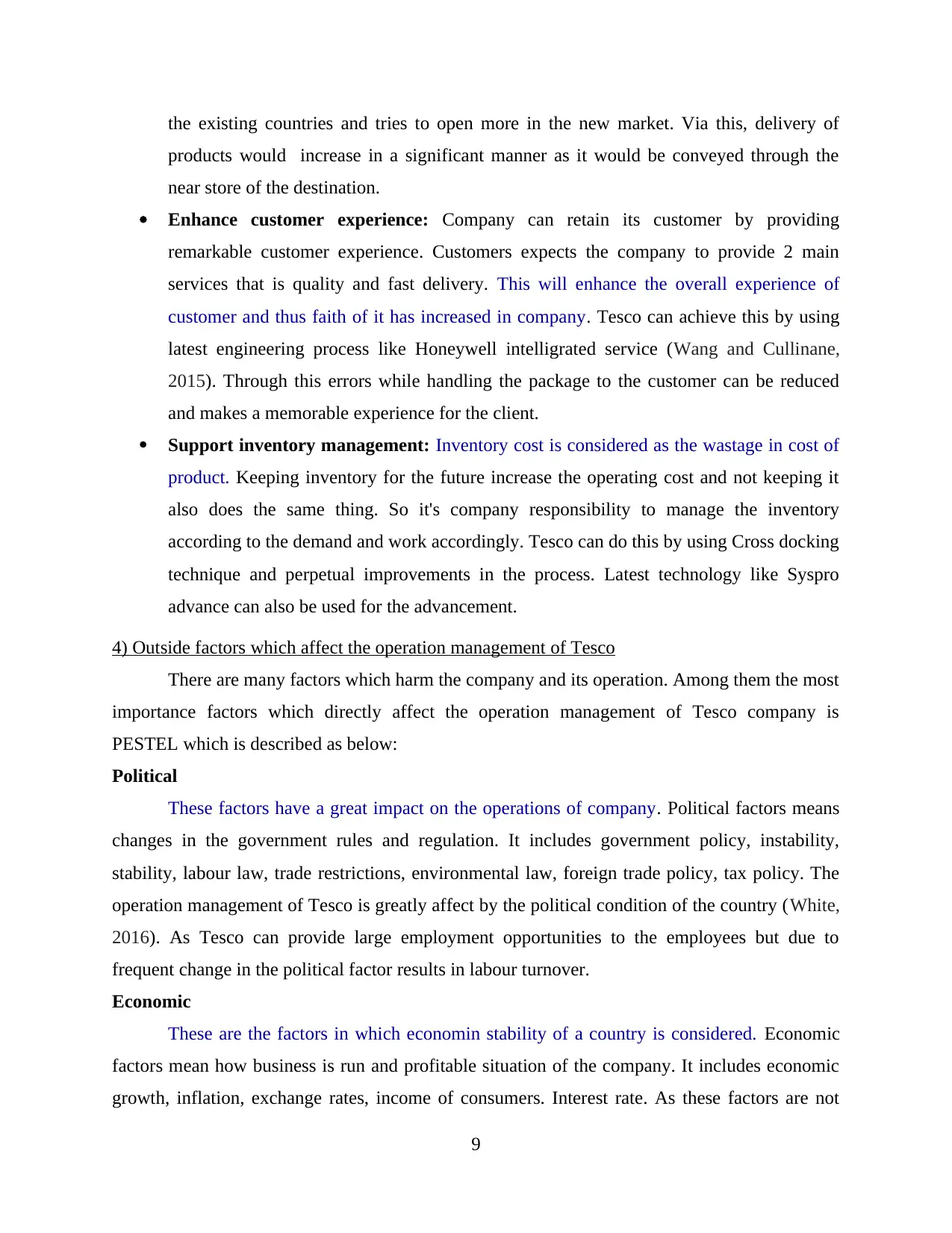
the existing countries and tries to open more in the new market. Via this, delivery of
products would increase in a significant manner as it would be conveyed through the
near store of the destination.
Enhance customer experience: Company can retain its customer by providing
remarkable customer experience. Customers expects the company to provide 2 main
services that is quality and fast delivery. This will enhance the overall experience of
customer and thus faith of it has increased in company. Tesco can achieve this by using
latest engineering process like Honeywell intelligrated service (Wang and Cullinane,
2015). Through this errors while handling the package to the customer can be reduced
and makes a memorable experience for the client.
Support inventory management: Inventory cost is considered as the wastage in cost of
product. Keeping inventory for the future increase the operating cost and not keeping it
also does the same thing. So it's company responsibility to manage the inventory
according to the demand and work accordingly. Tesco can do this by using Cross docking
technique and perpetual improvements in the process. Latest technology like Syspro
advance can also be used for the advancement.
4) Outside factors which affect the operation management of Tesco
There are many factors which harm the company and its operation. Among them the most
importance factors which directly affect the operation management of Tesco company is
PESTEL which is described as below:
Political
These factors have a great impact on the operations of company. Political factors means
changes in the government rules and regulation. It includes government policy, instability,
stability, labour law, trade restrictions, environmental law, foreign trade policy, tax policy. The
operation management of Tesco is greatly affect by the political condition of the country (White,
2016). As Tesco can provide large employment opportunities to the employees but due to
frequent change in the political factor results in labour turnover.
Economic
These are the factors in which economin stability of a country is considered. Economic
factors mean how business is run and profitable situation of the company. It includes economic
growth, inflation, exchange rates, income of consumers. Interest rate. As these factors are not
9
products would increase in a significant manner as it would be conveyed through the
near store of the destination.
Enhance customer experience: Company can retain its customer by providing
remarkable customer experience. Customers expects the company to provide 2 main
services that is quality and fast delivery. This will enhance the overall experience of
customer and thus faith of it has increased in company. Tesco can achieve this by using
latest engineering process like Honeywell intelligrated service (Wang and Cullinane,
2015). Through this errors while handling the package to the customer can be reduced
and makes a memorable experience for the client.
Support inventory management: Inventory cost is considered as the wastage in cost of
product. Keeping inventory for the future increase the operating cost and not keeping it
also does the same thing. So it's company responsibility to manage the inventory
according to the demand and work accordingly. Tesco can do this by using Cross docking
technique and perpetual improvements in the process. Latest technology like Syspro
advance can also be used for the advancement.
4) Outside factors which affect the operation management of Tesco
There are many factors which harm the company and its operation. Among them the most
importance factors which directly affect the operation management of Tesco company is
PESTEL which is described as below:
Political
These factors have a great impact on the operations of company. Political factors means
changes in the government rules and regulation. It includes government policy, instability,
stability, labour law, trade restrictions, environmental law, foreign trade policy, tax policy. The
operation management of Tesco is greatly affect by the political condition of the country (White,
2016). As Tesco can provide large employment opportunities to the employees but due to
frequent change in the political factor results in labour turnover.
Economic
These are the factors in which economin stability of a country is considered. Economic
factors mean how business is run and profitable situation of the company. It includes economic
growth, inflation, exchange rates, income of consumers. Interest rate. As these factors are not
9
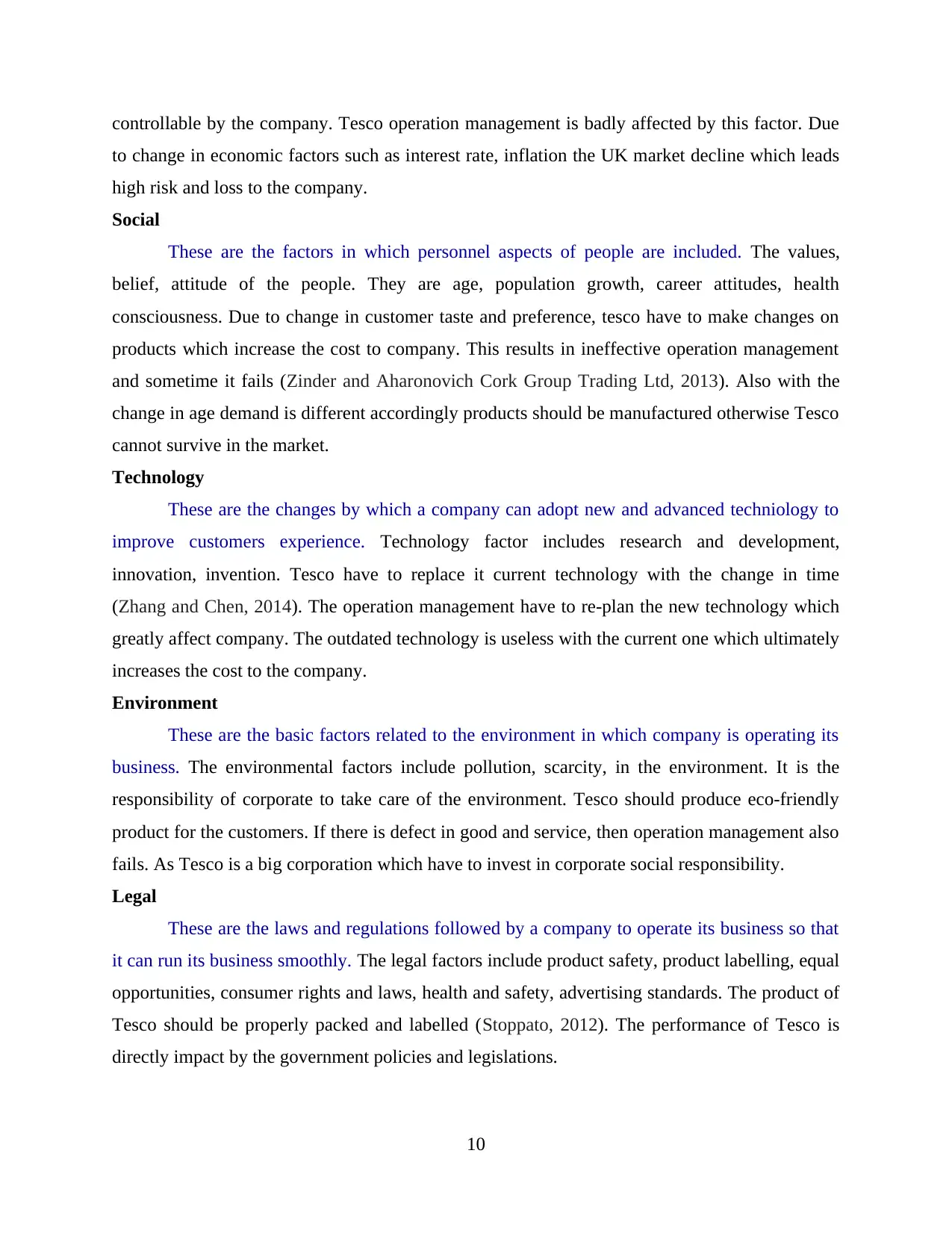
controllable by the company. Tesco operation management is badly affected by this factor. Due
to change in economic factors such as interest rate, inflation the UK market decline which leads
high risk and loss to the company.
Social
These are the factors in which personnel aspects of people are included. The values,
belief, attitude of the people. They are age, population growth, career attitudes, health
consciousness. Due to change in customer taste and preference, tesco have to make changes on
products which increase the cost to company. This results in ineffective operation management
and sometime it fails (Zinder and Aharonovich Cork Group Trading Ltd, 2013). Also with the
change in age demand is different accordingly products should be manufactured otherwise Tesco
cannot survive in the market.
Technology
These are the changes by which a company can adopt new and advanced techniology to
improve customers experience. Technology factor includes research and development,
innovation, invention. Tesco have to replace it current technology with the change in time
(Zhang and Chen, 2014). The operation management have to re-plan the new technology which
greatly affect company. The outdated technology is useless with the current one which ultimately
increases the cost to the company.
Environment
These are the basic factors related to the environment in which company is operating its
business. The environmental factors include pollution, scarcity, in the environment. It is the
responsibility of corporate to take care of the environment. Tesco should produce eco-friendly
product for the customers. If there is defect in good and service, then operation management also
fails. As Tesco is a big corporation which have to invest in corporate social responsibility.
Legal
These are the laws and regulations followed by a company to operate its business so that
it can run its business smoothly. The legal factors include product safety, product labelling, equal
opportunities, consumer rights and laws, health and safety, advertising standards. The product of
Tesco should be properly packed and labelled (Stoppato, 2012). The performance of Tesco is
directly impact by the government policies and legislations.
10
to change in economic factors such as interest rate, inflation the UK market decline which leads
high risk and loss to the company.
Social
These are the factors in which personnel aspects of people are included. The values,
belief, attitude of the people. They are age, population growth, career attitudes, health
consciousness. Due to change in customer taste and preference, tesco have to make changes on
products which increase the cost to company. This results in ineffective operation management
and sometime it fails (Zinder and Aharonovich Cork Group Trading Ltd, 2013). Also with the
change in age demand is different accordingly products should be manufactured otherwise Tesco
cannot survive in the market.
Technology
These are the changes by which a company can adopt new and advanced techniology to
improve customers experience. Technology factor includes research and development,
innovation, invention. Tesco have to replace it current technology with the change in time
(Zhang and Chen, 2014). The operation management have to re-plan the new technology which
greatly affect company. The outdated technology is useless with the current one which ultimately
increases the cost to the company.
Environment
These are the basic factors related to the environment in which company is operating its
business. The environmental factors include pollution, scarcity, in the environment. It is the
responsibility of corporate to take care of the environment. Tesco should produce eco-friendly
product for the customers. If there is defect in good and service, then operation management also
fails. As Tesco is a big corporation which have to invest in corporate social responsibility.
Legal
These are the laws and regulations followed by a company to operate its business so that
it can run its business smoothly. The legal factors include product safety, product labelling, equal
opportunities, consumer rights and laws, health and safety, advertising standards. The product of
Tesco should be properly packed and labelled (Stoppato, 2012). The performance of Tesco is
directly impact by the government policies and legislations.
10
⊘ This is a preview!⊘
Do you want full access?
Subscribe today to unlock all pages.

Trusted by 1+ million students worldwide
1 out of 16
Related Documents
Your All-in-One AI-Powered Toolkit for Academic Success.
+13062052269
info@desklib.com
Available 24*7 on WhatsApp / Email
![[object Object]](/_next/static/media/star-bottom.7253800d.svg)
Unlock your academic potential
Copyright © 2020–2025 A2Z Services. All Rights Reserved. Developed and managed by ZUCOL.




